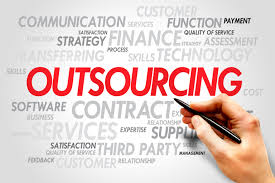Outsource Process
Outsource Process

MASTER your Strength, OUTSOURCE your weaknesses”– Ryan Kahn
For marriages, many specialized activities like makeup, decoration, food catering, photography etc. are outsourced. In many houses, cleaning of floor and utensils is outsourced. The economic prosperity of many developing nations is dependent on the business process outsourcing (BPO) like IT from developed nations.
Outsourcing is part and parcel of our daily life. Something similar is common in the industrial environment also. Although too much outsourcing creates new and unheard challenges to the organization and nations like COVID-19 situation in China.
What is the Outsource process?
Following are the 2 definitions from ISO 9000 and IATF 16949 (the intent is the same), which are self-explanatory.
Outsource (ISO 9000: 2015, Clause 3.4.6): Make an arrangement where an external organization performs part of an organization’s function or process. An external organization is outside the scope of the management system although the outsource process or function is within the scope.
Outsourced process (IATF 16949: 2016, Clause 3.0): Portion of an organization’s function (or processes) that is performed by an external organization
Following are the 6 different clauses of IATF 16949: 2016 and ISO 9001: 2015 which are specifically talking about Outsource process.
- Conformance of products and processes: 4. 4. 1.1
- Quality management system documentation: 7.5.1.1
- Operational planning and control: 8.1
- Prototype programme: 8.3.4.3
- Type and extent of control —- supplemental: 8.4.2. 1
- Management of production tooling: 8.5.1.6
Difference between Outsource process and Bought out Parts/Raw material:
There is a thin but distinct difference between the two.
In Outsource process, due to low capacity/competence, high cost of processing, inadequate space etc., a part of the manufacturing process is done by an external source and further value addition is done at the organization before despatching to customer. Example: Heat Treatment process, Welding/soldering process, Electroplating process, moulding process. In all the above examples, the key control over the manufacturing process lies with the organization but they outsource a part of it.
In Bought-out part/raw material, generally complete component/raw material is purchased from the supplier for further processing inside the organization. Example: Bulb, wiring harness, CRCA sheet, Chemicals, PCB etc.
In both the cases, based on the criticality and risk, requirements specified in clause 8.4 (Control of externally provided products) are to be implemented by the organization.
Why do the organization’s Outsource?
Business economics is key and the most pertinent reason for Outsourcing. To remain viable and competitive in the industry, organizations identify the processes wherein
- Low ROI-Return on Investment (Moulding, Fabrication)
- Heavy investment in machinery (Automatic Electroplating plant)
- The cost of processing is high (PCB-Printed Circuit Board)
- The competence of personnel is low (Product/Process Design, Rapid prototyping)
- The value addition is less (Welding, Soldering)
- Processing time is high (Heat Treatment)
- Low technology (Sheet cutting)
Possible challenges with Outsource process:
- Weak Management System (Competency, Calibration, poka-yoke)
- Poor selection process (clause 8.4)
- No structured Performance monitoring (Quality, Delivery, cost)
- Delivery performance is erratic (lack of strong QMS)
- Inadequate manufacturing process controls (job setup, in-process and final inspection)
- High rejection (Segregation, Rework, Repair, Scrap)
Controls need to make Outsource process effective:
- Specific Quality Objectives like on-time delivery, Rejections in ppm, number of complaints etc.
- Awareness and understanding about statutory and regulatory requirements (Trivalent plating), customer requirements (record retention, inspection frequency, the competence of personnel etc.)
- Effective documented information like Quality Manual to include process sequence and interaction for all the outsource process (like the interaction of Purchase, stores and incoming inspection process with outsourcing moulding process)
- Define Competency of personnel working at outsourcing processes like Heat Treatment process, Calibration process, Moulding process, Electroplating process, Tooling process etc.
- Traceability requirement (to ensure FIFO, inventory control, to track rejected material)
- An effective process of Control of non-conforming products & services (how to deal with NC product like segregation, repair, rework or scrap) and its communication with the organization
- Establish Inspection Controls on the outsource processes, products and services depending upon the criticality & risk like 2nd party audit, deputing organization’s person at outsourcing process end, third party inspection before despatch, selection process, communication process etc. Example: In a printing organization, paper quality could be critical. However, for a travel agency, it may not be.
Benefits from Outsource process:
- High-quality product to the customer
- Improved ROI
- Low Cost of Production
- Improvement in Manufacturing Efficiency
- Technological advantage
- Reduction in development time
- Enhanced customer satisfaction
Possible Challenges:
- Involvement of top management is limited for outsourcing processes
- Majority of the organizations do not have structured supplier selection process for outsourcing.
- Supplier performance monitoring is generally ignored for outsourcing processes. Hence Quality and delivery performance is generally erratic
- No structured plan for up-gradation of outsourcing process suppliers
References:
ISO 9000: 2015
ISO 9001: 2015
ISO/TS 9002: 2016
IATF 16949: 2016
This is the 60th article of this Quality Management series. Every weekend, you will find useful information that will make your Management System journey Productive. Please share it with your colleagues too.
Your genuine feedback and response are extremely valuable. Please suggest topics for the coming weeks.

Recent Posts
Recent Comments
- Bhavya Mangla on Fear Begets Fear: Tame the Beast Within
- OnlyWikis on Fear Begets Fear: Tame the Beast Within
- Bhavya Mangla on What is the key difference between RPN (Risk Priority Number) and Action Priority (AP) -FMEA?
- Bhavya Mangla on What is the key difference between Cp and Cpk?
- Devendra Negi on What is the key difference between Cp and Cpk?
Make vs Buy is important.Even in existing set up this aspect is to be considered. Makeing in house do include ROI but COGM becomes important
Rightly said Mr Khanna. Good to see your response.